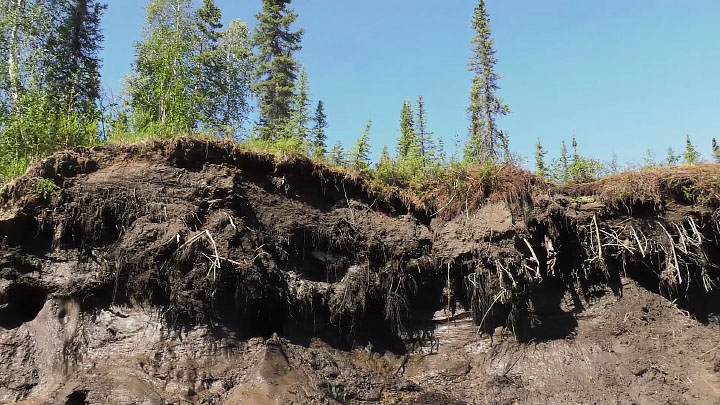

Winter carbon emissions from Arctic regions appear to be adding more carbon to Earth’s atmosphere each year than is being taken up by Arctic plants and trees. It is a stark reversal for a region that has captured and stored carbon for tens of thousands of years.
In a study published in Nature Climate Change, scientists estimated that 1.7 billion metric tons of carbon were lost from Arctic permafrost regions during each winter from 2003 to 2017. Over the same span, an average of 1 billion metric tons of carbon were taken up by vegetation during summer growing seasons. This changes the region from being a net “sink” of carbon dioxide—where it is captured from the atmosphere and stored—into being a net source of emissions.
Permafrost is the carbon-rich frozen soil that covers about one quarter of Northern Hemisphere land area; it encompasses vast stretches of Alaska, Canada, Siberia, and Greenland. Scientists have estimated that permafrost stores more carbon than has ever been released by humans via fossil fuel combustion. These frozen soils have kept carbon safely locked away for thousands of years, but rising temperatures are making them thaw and release those greenhouse gases.
The map above shows the estimated annual winter (October to April) emissions of carbon dioxide for Arctic permafrost regions from 2003 to 2017. A team of more than 70 researchers compiled ground-based observations of carbon dioxide emissions and combined them with remote sensing data and ecosystem models to assess current and future carbon losses.
“These findings indicate that winter carbon dioxide loss may already be offsetting growing season carbon uptake, and these losses will increase as the climate continues to warm,” said Sue Natali, lead author of the study and a scientist at Woods Hole Research Center (WHRC). “Studies focused on individual sites have seen this transition, but until now we haven’t had a clear accounting of the winter carbon balance throughout the entire Arctic region.”

Natali and colleagues warned that winter carbon dioxide losses from permafrost regions could increase by 41 percent over the next century if human-caused greenhouse gas emissions continue at their current pace. If fossil fuel use is modestly reduced, winter carbon dioxide emissions would increase 17 percent compared with current emissions. Carbon emitted from permafrost has not been included in most models of future climates.
“The warmer it gets, the more carbon will be released into the atmosphere from the permafrost region, which will add to further warming,” said co-author and WHRC scientist Brendan Rogers. “It’s concerning that our study, which used many more observations than ever before, indicates a much stronger Arctic carbon source in the winter. We may be witnessing a transition from an annual Arctic carbon sink to a carbon source, which is not good news.”
The study was supported by NASA’s Arctic-Boreal Vulnerability Experiment (ABoVE) and conducted in coordination with the Permafrost Carbon Network and more than 50 collaborating institutions.
NASA Earth Observatory image by Joshua Stevens, using data from Natali, S.M., et al. (2019). NASA photograph of permafrost by Jefferson Beck. Story by Samson Reiny, NASA Earth Science News Team, and Miles Grant, Woods Hole Research Center.